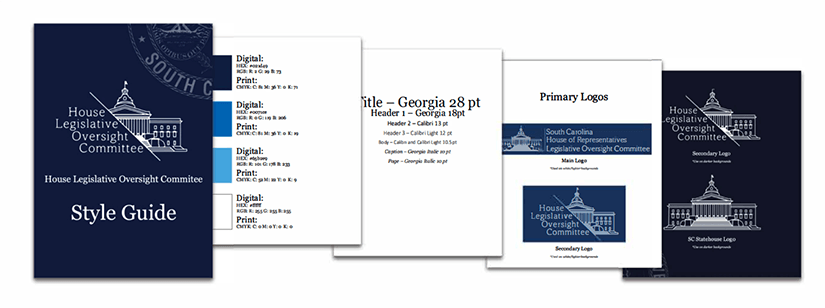A group of design students put their skills into action this semester to help a South Carolina legislative committee streamline its communications. In just three weeks, 13 graphic designers collaborated to create engaging and accessible options to help the committee more effectively communicate with the public.
In July, the SC House Legislative Oversight Committee (HLOC) reached out to the University of South Carolina for help improving its publication and product designs to make them more useful. Meena Khalili’s Graphic Design + Illustration BFA students answered that call.
“This generation of students takes government very seriously, and they wanted to be sure to make a lasting impact,” says Khalili, an associate professor of studio art.
To achieve this impact, the students met with committee members to find out more about their unique needs. They learned their top priorities were to solve challenges with text readability on print materials, website accessibility, functionality and overall impact.
Khalili often connects her students to organizations in the community that need assistance with design. But up to this point, most of Khalili’s UofSC students had not worked with such a high-profile client. Working with HLOC gave them an opportunity to make a difference in the lives of everyone across South Carolina.
“They got to support everyone in this state,” says Khalili. “We are all online, so the more easily we understand how the systems in our state work for us, the better we can support our state, and the students got to help with that.”
As the investigative committee for the entire House of Representatives, HLOC must ensure that state agencies operate as efficiently as possible. The committee suggests ways to improve agencies while keeping the public informed about their policies.
That oversight turned self-reflective this summer when the committee realized its own communications were lacking in accessibility and efficiency.
Jadyn Velpula, a junior art studio major, worked on design for the committee’s weekly newsletter. She created new icons to establish visual consistency throughout the redesign.
Velpula says having the trust of the committee to make design decisions was an important experience and a big step toward what it will be like working in her eventual career.
“I loved having a level of creative control over what to deliver to the committee,” Velpula says. “They presented us with a problem and asked us to do what we think is best. We were not only able to pitch our new designs back to them but explain to them why we made certain artistic choices.”
Velpula says this experience gave her a better understanding of what it will be like designing as a professional for clients who may not have much background in design. That was a major factor in how the students approached their design presentations, because, along with the challenges of designing for such an important client, the students learned they’d have to create designs using one of the few programs that HLOC has access to — Microsoft Word.
While it was a challenge, Khalili says the students came prepared and they were able to navigate the barrier with ease.
“Like many of our clients, the committee has access to limited software,” Khalili says. “But the first question the students asked was, ‘What programs do you use?’ That was the moment I knew they had it in the bag.”
The committee recognized Khalili and her students at the start of its Oct. 4 meeting, and again on Oct. 24, where the committee utilized the new presentation format for its most recent findings.
The updates include visual solutions that will make it easier for lawmakers to see the important data points in their presentations and a new identity system which includes logos, websafe typefaces and even incorporates elements from the Columbia flag, designed by SVAD alumnus Nate Puza. Eventually, the committee will also adopt a streamlined website with an intuitive search option, once it has been finalized.
Khalili’s students won’t get much downtime after completing the HLOC redesign. Their other clients this semester include the First Year Reading Experience and UofSC’s women’s soccer team. All the hands-on experience serves as invaluable preparation for entering the job market, Khalili says.
“By senior year, the students are used to talking about and presenting their work, that sets them up for job success,” she says. “Their level of professionalism is the kind that employers can trust.”
SVAD students will soon have even more opportunities to engage with the community. With the support of the college’s McCausland Innovation Fund, Khalili and other design faculty members are creating a student-run design studio that will give students even more opportunities to complete projects for external clients.
